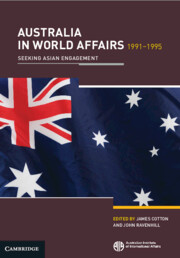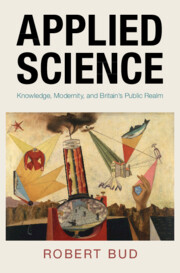246 results
10 - Southern Africa
- from Part III - Africa and Pahlavi Iran’s Grand Strategy (1976–1979)
-
- Book:
- Pahlavi Iran's Relations with Africa
- Print publication:
- 27 June 2024, pp 254-280
-
- Chapter
- Export citation
Introduction
-
-
- Book:
- Europe in British Literature and Culture
- Print publication:
- 13 June 2024, pp 1-18
-
- Chapter
- Export citation
Public Preferences Over Changes to the Composition of Government Tax Revenue
-
- Journal:
- British Journal of Political Science , First View
- Published online by Cambridge University Press:
- 17 May 2024, pp. 1-11
-
- Article
-
- You have access
- Open access
- HTML
- Export citation

Australia in World Affairs 1991–1995
- Seeking Asian Engagement
-
- Published online:
- 04 May 2024
14 - Australia and the European Union
-
-
- Book:
- Australia in World Affairs 1991–1995
- Published online:
- 04 May 2024, pp 167-180
-
- Chapter
- Export citation
8 - Australia and Europe
- from Part II - Relationships
-
-
- Book:
- Australia in World Affairs 1996–2000
- Published online:
- 04 May 2024, pp 91-103
-
- Chapter
- Export citation
The Ethical Principles in Ethical Guidance Documents during the COVID-19 Pandemic in the United Kingdom and the Republic of Ireland: A Qualitative Systematic Review
-
- Journal:
- Prehospital and Disaster Medicine , First View
- Published online by Cambridge University Press:
- 03 May 2024, pp. 1-11
-
- Article
-
- You have access
- Open access
- HTML
- Export citation
12 - Does Big Brother Exist?
- from Part II - Facial Recognition Technology across the Globe
-
-
- Book:
- The Cambridge Handbook of Facial Recognition in the Modern State
- Published online:
- 28 March 2024
- Print publication:
- 04 April 2024, pp 173-185
-
- Chapter
-
- You have access
- Open access
- HTML
- Export citation
10 - Australia and the United Kingdom
- from Part 2 - Australia and the Regions
-
-
- Book:
- Australia in World Affairs 1981–1990
- Published online:
- 29 March 2024, pp 198-207
-
- Chapter
- Export citation
8 - The United Kingdom
-
-
- Book:
- Australia in World Affairs 1971–1975
- Published online:
- 29 March 2024, pp 209-230
-
- Chapter
- Export citation

Applied Science
- Knowledge, Modernity, and Britain's Public Realm
-
- Published online:
- 15 March 2024
- Print publication:
- 28 March 2024
Chapter 8 - The Rise and Fall of the Foreign Secretary, 1782–2024
-
- Book:
- The Impossible Office?
- Published online:
- 14 March 2024
- Print publication:
- 14 March 2024, pp 313-348
-
- Chapter
- Export citation
2 - Social Justice within a Market Society
-
-
- Book:
- Social Justice in Twentieth-Century Europe
- Published online:
- 29 February 2024
- Print publication:
- 07 March 2024, pp 30-52
-
- Chapter
- Export citation
14 - The UK’s Compliance with the ICCPR and ECHR: A Tale of Two Treaties
- from Part V - Human Rights
-
-
- Book:
- International Courts versus Non-Compliance Mechanisms
- Published online:
- 15 February 2024
- Print publication:
- 22 February 2024, pp 314-333
-
- Chapter
-
- You have access
- Open access
- HTML
- Export citation
13 - Exchange Rates, Tariffs and Prices in 1930s Britain
-
-
- Book:
- Keynes's <i>Economic Consequences of the Peace</i> after 100 Years
- Published online:
- 14 December 2023
- Print publication:
- 25 January 2024, pp 325-363
-
- Chapter
- Export citation
Coping with COVID-19 lockdown: a qualitative study of older adults in alcohol treatment
-
- Journal:
- Ageing & Society , First View
- Published online by Cambridge University Press:
- 19 January 2024, pp. 1-18
-
- Article
- Export citation
15 - United Kingdom: Labour Law and Technological Authoritarianism at Work: Past, Present, and Future
-
-
- Book:
- The Cambridge Handbook of Technological Disruption in Labour and Employment Law
- Published online:
- 07 December 2023
- Print publication:
- 21 December 2023, pp 245-267
-
- Chapter
- Export citation
Dementia: A call for a paradigm shift in pre-registration nurse education
-
- Journal:
- Cambridge Prisms: Global Mental Health / Volume 11 / 2024
- Published online by Cambridge University Press:
- 04 December 2023, e2
-
- Article
-
- You have access
- Open access
- HTML
- Export citation
The return of Prometheus. Dominant powers and the management of careful revisionists
-
- Journal:
- Italian Political Science Review / Rivista Italiana di Scienza Politica / Volume 54 / Issue 1 / March 2024
- Published online by Cambridge University Press:
- 04 December 2023, pp. 84-100
- Print publication:
- March 2024
-
- Article
-
- You have access
- Open access
- HTML
- Export citation
Globalization and Empire: Market Integration and International Trade among Canada, the US, and Britain, 1750–1870
-
- Journal:
- Social Science History / Volume 48 / Issue 1 / Spring 2024
- Published online by Cambridge University Press:
- 13 November 2023, pp. 19-40
- Print publication:
- Spring 2024
-
- Article
-
- You have access
- Open access
- HTML
- Export citation



